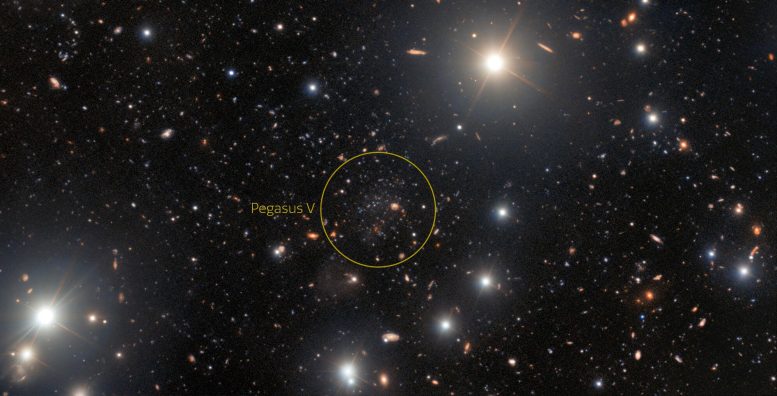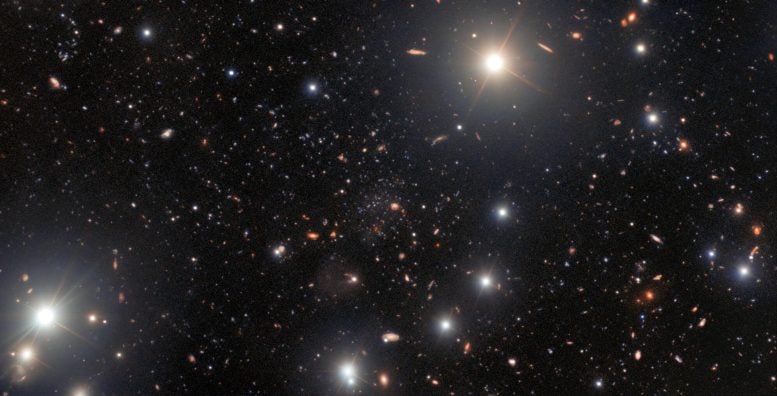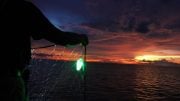
An amateur astronomer’s keen eyes led to the discovery of an unusual ultra-faint dwarf galaxy on the outskirts of the Andromeda Galaxy. Credit: International Gemini Observatory/NOIRLab/NSF/AURA, Acknowledgment: Image processing: T.A. Rector (University of Alaska Anchorage/NSF’s NOIRLab), M. Zamani (NSF’s NOIRLab) & D. de Martin (NSF’s NOIRLab)
Gemini North telescope reveals a relict of the earliest galaxies.
A unique ultra-faint dwarf galaxy has been discovered on the outer fringes of the Andromeda Galaxy thanks to the discerning eyes of an amateur astronomer examining archival data processed by NSF’s NOIRLab’s Community Science and Data Center. The dwarf galaxy — Pegasus V — was revealed to contain very few heavier elements and is likely to be a fossil of the first galaxies in follow-up observations by professional astronomers using the International Gemini Observatory, a Program of NSF’s NOIRLab.
An unusual ultra-faint dwarf galaxy has been discovered on the edge of the Andromeda Galaxy with the help of several facilities of NSF’s NOIRLab. Called Pegasus V, the galaxy was first detected as part of a systematic search for Andromeda dwarfs coordinated by David Martinez-Delgado from the Instituto de Astrofísica de Andalucía, Spain, when amateur astronomer Giuseppe Donatiello discovered a curious ‘smudge’ in data in a DESI Legacy Imaging Surveys image.[1] The image was taken with the US Department of Energy-fabricated Dark Energy Camera on the Víctor M. Blanco 4-meter (13-foot) Telescope at Cerro Tololo Inter-American Observatory (CTIO). The data were processed through the Community Pipeline which is operated by NOIRLab’s Community Science and Data Center (CSDC).
Faint stars in Pegasus V were revealed in follow-up deeper observations by astronomers using the larger, 8.1-meter (26.6-foot) Gemini North telescope with the GMOS instrument, confirming that it is an ultra-faint dwarf galaxy on the outskirts of the Andromeda Galaxy. Gemini North in Hawai‘i is one-half of the International Gemini Observatory.
The observations with Gemini showed that the galaxy appears to be extremely deficient in heavier elements compared to similar dwarf galaxies, meaning that it is very old and likely to be a fossil of the first galaxies in the Universe.
“We have found an extremely faint galaxy whose stars formed very early in the history of the Universe,” commented Michelle Collins, an astronomer at the University of Surrey, UK and lead author of the paper announcing this discovery. “This discovery marks the first time a galaxy this faint has been found around the Andromeda Galaxy using an astronomical survey that wasn’t specifically designed for the task.”

A unique ultra-faint dwarf galaxy has been discovered in the outer fringes of the Andromeda Galaxy thanks to the sharp eyes of an amateur astronomer examining archival data from the US Department of Energy-fabricated Dark Energy Camera on the Víctor M. Blanco 4-meter Telescope at Cerro Tololo Inter-American Observatory (CTIO) and processed by the Community Science and Data Center (CSDC). Follow-up by professional astronomers using the International Gemini Observatory revealed that the dwarf galaxy — Pegasus V — contains very few heavier elements and is likely to be a fossil of the first galaxies. All three facilities involved are Programs of NSF’s NOIRLab. Credit: International Gemini Observatory/NOIRLab/NSF/AURA, Acknowledgment: Image processing: T.A. Rector (University of Alaska Anchorage/NSF’s NOIRLab), M. Zamani (NSF’s NOIRLab) & D. de Martin (NSF’s NOIRLab)
The faintest galaxies are considered to be fossils of the very first galaxies that formed, and these galactic relics contain clues about the formation of the earliest stars. While astronomers expect the Universe to be teeming with faint galaxies like Pegasus V,[2] they have not yet discovered nearly as many as their theories predict. If there are truly fewer faint galaxies than predicted this would imply a serious problem with astronomers’ understanding of cosmology and dark matter.
Discovering examples of these faint galaxies is, therefore, an important endeavor, but also a difficult one. Part of the challenge is that these faint galaxies are extremely tricky to spot, appearing as just a few sparse stars hidden in vast images of the sky.
“The trouble with these extremely faint galaxies is that they have very few of the bright stars which we typically use to identify them and measure their distances,” explained Emily Charles, a PhD student at the University of Surrey who was also involved in the study. “Gemini’s 8.1-meter mirror allowed us to find faint, old stars which enabled us both to measure the distance to Pegasus V and to determine that its stellar population is extremely old.”
The strong concentration of old stars that the team found in Pegasus V suggests that the object is likely a fossil of the first galaxies. When compared with the other faint galaxies around Andromeda, Pegasus V seems uniquely old and metal-poor, indicating that its star formation ceased very early indeed.
“We hope that further study of Pegasus V’s chemical properties will provide clues into the earliest periods of star formation in the Universe,” concluded Collins. “This little fossil galaxy from the early Universe may help us understand how galaxies form, and whether our understanding of dark matter is correct.”
“The public-access Gemini North telescope provides an array of capabilities for community astronomers,” said Martin Still, Gemini Program Officer at the National Science Foundation. “In this case, Gemini supported this international team to confirm the presence of the dwarf galaxy, associate it physically with the Andromeda Galaxy, and determine the metal-deficient nature of its evolved stellar population.”
Upcoming astronomical facilities are set to shed more light on faint galaxies. Pegasus V was witness to a time in the history of the Universe known as reionization, and other objects dating back to this time will soon be observed with NASA’s James Webb Space Telescope. Astronomers also hope to discover other such faint galaxies in the future using Vera C. Rubin Observatory, a Program of NSF’s NOIRLab. Rubin Observatory will conduct an unprecedented, decade-long survey of the optical sky called the Legacy Survey of Space and Time (LSST).
Notes
- The DESI Legacy Imaging Surveys were conducted to identify targets for the Dark Energy Spectroscopic Instrument (DESI) operations. These surveys comprise a unique blend of three projects that have observed a third of the night sky: the Dark Energy Camera Legacy Survey (DECaLS), observed by the DOE-built Dark Energy Camera (DECam) on the Víctor M. Blanco 4-meter Telescope at Cerro Tololo Inter-American Observatory (CTIO) in Chile; the Mayall z-band Legacy Survey (MzLS), by the Mosaic3 camera on the Nicholas U. Mayall 4-meter Telescope at Kitt Peak National Observatory (KPNO); and the Beijing-Arizona Sky Survey (BASS) by the 90Prime camera on the Bok 2.3-meter (7.5-foot) Telescope, which is owned and operated by the University of Arizona and located at KPNO. CTIO and KPNO are Programs of NSF’s NOIRLab.
- Pegasus V is so named because it is the fifth dwarf galaxy discovered located in the constellation Pegasus. The on-sky separation between Pegasus V and the Andromeda Galaxy is about 18.5 degrees.
More information
This research was presented in a paper entitled “Pegasus V — a newly discovered ultra-faint dwarf galaxy on the outskirts of Andromeda” to appear in Monthly Notices of the Royal Astronomical Society.
Reference: “Pegasus V — a newly discovered ultra-faint dwarf galaxy on the outskirts of Andromeda” by Michelle L. M. Collins, Emily J. E. Charles, David Martínez-Delgado, Matteo Monelli, Noushin Karim, Giuseppe Donatiello, Erik J. Tollerud and Walter Boschin, 27 July 2022, Monthly Notices of the Royal Astronomical Society.
DOI: 10.1093/mnrasl/slac063
The team is composed of Michelle L. M. Collins (Physics Department, University of Surrey, UK), Emily J. E. Charles (Physics Department, University of Surrey, UK), David Martínez-Delgado (Instituto de Astrofísica de Andalucía, Spain), Matteo Monelli (Instituto de Astrofísica de Canarias (IAC) and Universidad de La Laguna, Spain), Noushin Karim (Physics Department, University of Surrey, UK), Giuseppe Donatiello (UAI – Unione Astrofili Italiani, Italy), Erik J. Tollerud (Space Telescope Science Institute, USA), Walter Boschin (Instituto de Astrofísica de Canarias (IAC), Universidad de La Laguna, and Fundación G. Galilei – INAF (Telescopio Nazionale Galileo), Spain).









Please call these stories “opinions”, “guesses” and “theories”, readers will believe the stories are true.
What do we call your dog… I mean, god, then? Drunken fantasies of stone age goat herders?
We’ll call your comment your personal opinion.
But the article is about observed facts.
Actually, all galaxies, including Andromeda and the Milky Way, are of a similar age. What is distinct about the metal poor “fossil” galaxies is that they stopped producing stars, while galaxies like ours continued producing further generations of stars.
The stopping of star production may have had to do with the small size of the galaxies, which might not have had enough mass to hold on to most of the supernova debris, or the available cold gas may have been stripped away by encounters with larger galaxies or by their own central black holes.
Flagman, your objections tell me you have little understanding of the term theory and by implication, science. The story title is fine for popular press
Some relic galaxies may have been absorbed by,and imbedded into, younger galaxies, perhaps completely torn apart in the process.
I come from Florida. I know plenty about palmetto bugs and roaches. I can give anyone that asks a number to call for professional extermination or you can ask google for one in your neighborhood. You can use raid roach motels, takes 3 months to eliminate all pests but most are gone in less time. You can use a very cheap and effective powder that does take a full three to six months but I have seen it clean out South American hospitals, that have way more than their share of bugs and that were spending huge amounts of money on the problem. The name of the “magic” powder is boric acid.
Now, you need never see another miserable roach or palmetto bug ever again. So PLEASE get rid of these horrible pictures of bugs and coffee cups. Sickening.